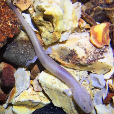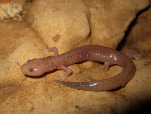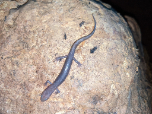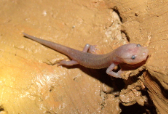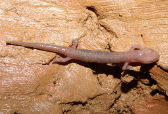Northern Grotto Salamander (Eurycea nerea)
Description:
Adult grotto salamanders are pale tan to pale pink. A cave dweller, this species lacks gills in the adult form and is partly or completely blind. The head is rather wide and flat. The tail is long, slender, and finless. There are 16 to 19 grooves along the side. The eyes are small and are partially or fully covered by the eyelids. The eyes may appear sunken into the head. The larvae have gills, functional eyes, and broad tail fins; they have more pigment than adults, being brown to dark gray, sometimes with spots or streaking on the sides and tail.
This is a troglobitic species that has evolved several troglomorphisms such as a pale coloration and reduced eyesight. Alongside E. spelaea and E. braggi, it is the only blind, troglobitic salamander that undergoes full metamorphosis.
Habitat: It inhabits freshwater springs (as a juvenile), inland karsts, and caves.
Range: It is found in the southern Ozark Plateau of Missouri and adjacent portions of Arkansas. It is primarily found in the Salem Plateau and a small portion of the adjacent West Springfield Plateau.
Found in these States:
AR |
MO
Diet: Adults eat mainly small aquatic and terrestrial invertebrates, as well as the larvae of other Eurycea salamanders.
Reproduction: Reproduction in grotto salamanders is not well studied due mainly to their secretive habits in caves. Apparently, adults mate during the late spring into the summer months due to an influx of nutrients (in the form of bat guano) that support this period, when the salamanders require their greatest food supply.
Fertilization is internal (as with most salamanders), and females apparently lay eggs within 1 to 4 months after mating. The eggs are probably attached to stones in or near water in caves. The larvae are aquatic and normally inhabit cave streams; sometimes, however, they are found in springs or streams that flow out of caves. They may take 2 to 3 years, or sometimes up to 6 years, to transform into adults. The estimated lifespan in the wild is at least 9 years.
Status: Listed as Least Concern in view of its wide distribution, presumed large population, and because it is unlikely to be declining fast enough to qualify for listing in a more threatened category.
Taxonomy: It was described in 1968, but was later synonymized with the western grotto salamander (E. spelaea), but a 2017 study found substantial genetic differences between the clades classified in E. spelaea and once again split them into distinct species.
»» Kingdom: Animalia - Animals
»» Phylum: Chordata - Chordates
»» Subphylum: Vertebrata - Vertebrates
»» Class: Amphibia - (Amphibians)
»» Order: Caudata - Salamanders
»» Family: Plethodontidae - Lungless Salamanders
»» Genus: Eurycea
»» Species: Eurycea nerea - Northern Grotto Salamander
This article uses material from the Wikipedia article "Northern Grotto Salamander", which is released under the Creative Commons Attribution-Share-Alike License 3.0. Content may have been omitted from the original, but no content has been changed or extended.
|



